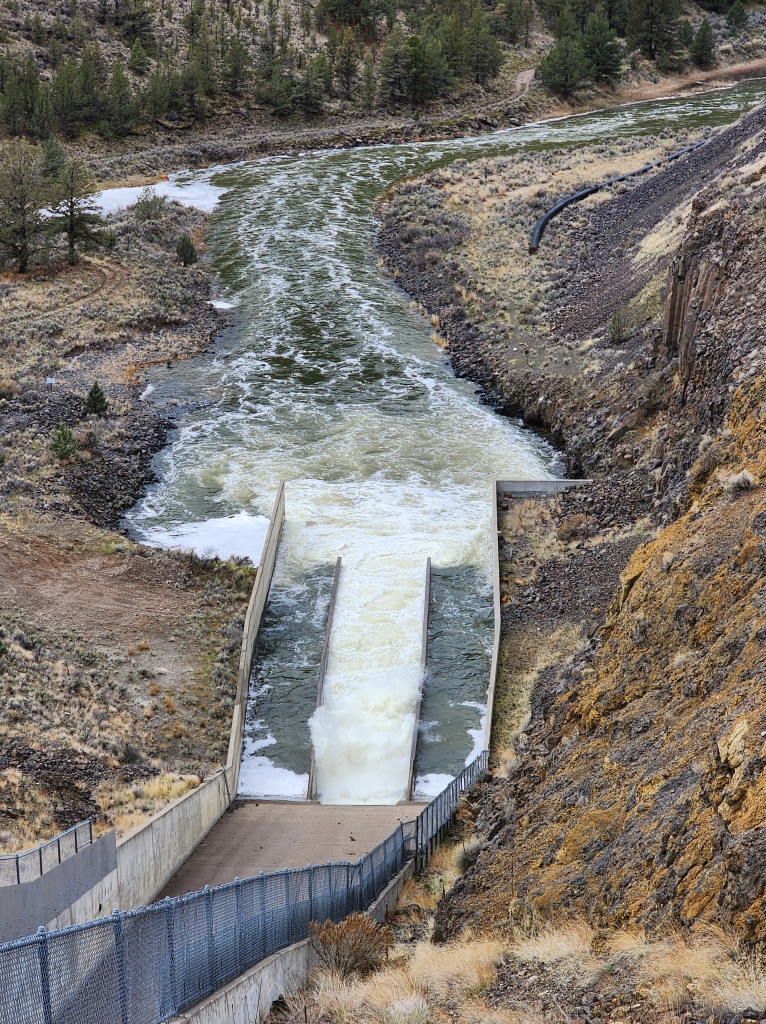The Source Weekly called me a few days ago to talk about my recent post, USDA: most local irrigators are not farmers. Yesterday they ran a decent story on the topic. There are things I would have included in the article, but I was impressed, especially given that the reporter had not previously covered water issues in Central Oregon. Frankly, it was refreshing to not feel compelled to write a criticism of local coverage like I do too often. I hope the reporter sticks around.
Badgers in the Middle Deschutes canyon
A reader and fellow member of Central Oregon Flyfishers sent me this photo from a trail cam in his back yard. He lives overlooking the Middle Deschutes near Eagle Crest. A USFW biologist confirmed that it’s a badger. As the bio said, “pretty cool”!

I just can’t stop looking…
This says it all. An irrigation ditch or habitat for aquatic species? You decide.

Phil Chang for Deschutes County Commission
As a teenager my dream was to become a U.S. Senator. A few years of studying politics and philosophy as an undergraduate quickly dissuaded me from this ambition. For all of my adult life I have had little respect for politicians or political parties. Even at the local level it is rare to find candidates that deserve support. Even the ones who have called me and successfully wrangled a contribution after pledging to be a champion for water and environmental issues have failed to deliver. Needless to say, I am a deep skeptic. As Plato wrote over 2,000 years ago, the desire for office should disqualify you. Nevertheless, I am doing something extremely uncharacteristic and endorsing Phil Chang for Deschutes County Commissioner. I have lived in Central Oregon for 20 years and Phil is the only local politician who has educated themselves about local environmental issues, including water, and consistently advocated and voted accordingly.
Another disappointing article in the Bulletin
On March 30th I wrote a post titled, “It’s spring and fish killing season”, and simultaneously sent it to the Bulletin for their consideration as a guest opinion column. It does not bother me that the paper did not publish my submission. They are a private business, not a public utility, and can chose to publish what they think best serves their economic interests. If they think readers would prefer to see nationally syndicated columnists over local items of interest, it’s their prerogative. Then, two days ago, this article appeared in the paper, which is clearly based on my writing. I have no issue with this either. Writing a longer story based on my submission is fine, the topic deserves more than the 650 words to which a guest column is confined. What does bother me, however, is the continued deference to irrigators and lack of concern for fish and wildlife issues, especially when I so clearly discussed them.
Read More »Beating a dead horse, I guess
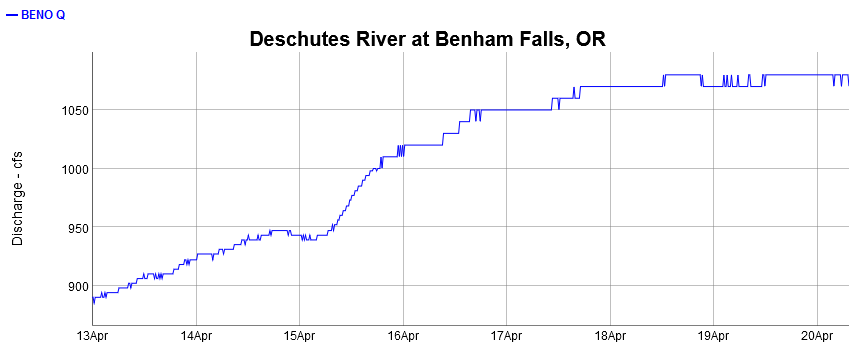
I write a lot about irrigation flows and its impact on local rivers, but today’s graphs once again illustrate the point. Irrigation season is underway with 25% of the water being delivered. This will be ramped up to full delivery by mid-May. Above is the Bureau of Reclamation chart for the Deschutes River at Benham Falls. It shows a relatively measured increase in flows, an increase that has generated sediment in the river but not extreme levels. In contrast, look at the chart for the river below the final irrigation diversions at North Canal Dam.
Read More »USDA: most local irrigators are not farmers
As I posted last August, every five years the US Depart of Agriculture conducts a “Census of Agriculture“, which they claim is a complete count of U.S. farms and ranches. “Even small plots of land – whether rural or urban – count if $1,000 or more of such products were raised and sold, or normally would have been sold, during the census year. The Census of Agriculture, taken only once every five years, looks at land use and ownership, operator characteristics, production practices, income and expenditures.” Last week the 2022 census was released and it once again clearly shows that while there is some important local commercial agriculture, most Central Oregon irrigators are not farmers as defined by the USDA. Given the fact that approximately 86% of all local water is used by irrigators, understanding where water is going is important for all of us.
Read More »The acclimation tank at Whychus Creek
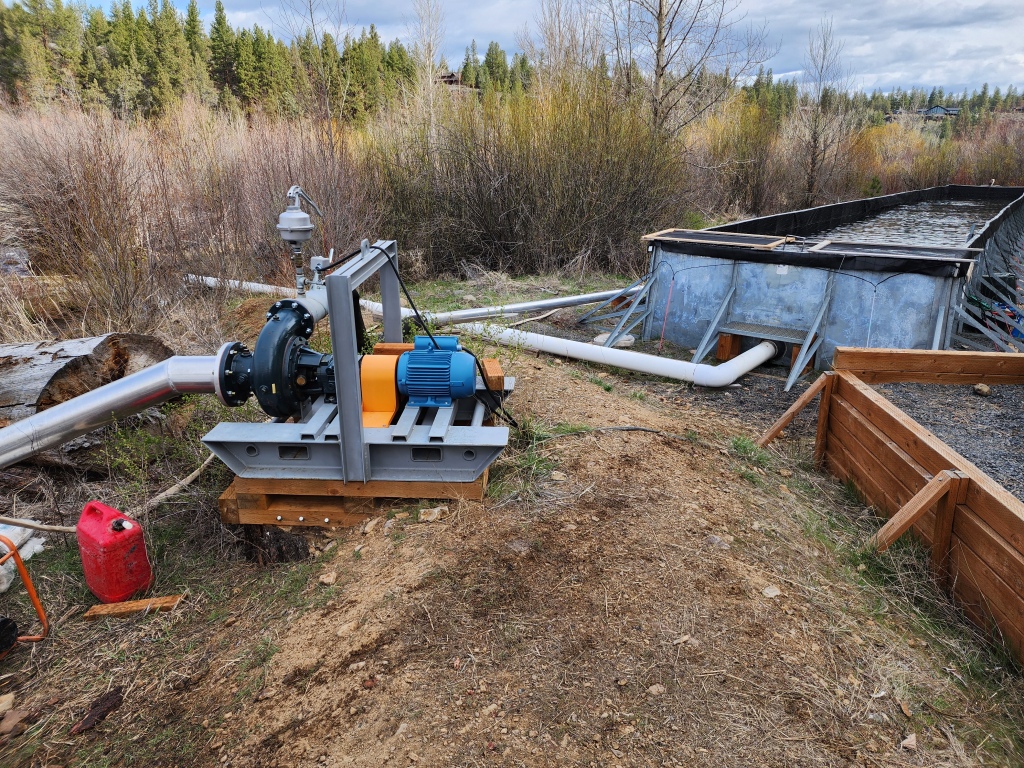
I recently wrote about how the beginning of irrigation season can be lethal to fish and gave an example of Three Sisters Irrigation District abruptly de-watering part of Whychus Creek last month, killing spring chinook smolts being prepared for release into the creek. Yesterday I accompanied a local agency employee to the acclimation tank to take a look.
Read More »ODFW 2025-2027 budget preparation
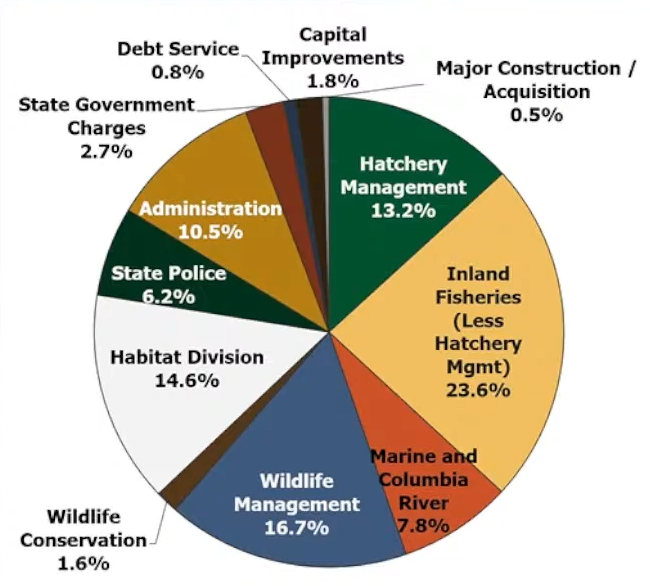
ODFW is the only state agency that actively solicits public input when developing its budget. That process for the 2025-2027 biennium is now underway. I have been attending these meetings for many years. They have been illuminating and frustrating. If you want to understand how ODFW works, I encourage you to watch the video of the first public budget meeting which occurred last week, review the listed materials, and perhaps submit written comments. The good news is that a perennially underfunded agency has seen its budget grow recently and they have been able to undertake some good projects. Of course, much more needs to be done with a potentially smaller future budget. Side bar: For years, I have been an ODFW volunteer in a variety of ways and think they could improve in many areas, but am saddened by how often I hear department criticism that is mostly uniformed. Watching this video is a great way to start to understand how they make decisions.
It’s spring and fish killing season
Spring brings the beginning of irrigation season in Central Oregon. Irrigation districts usually start water deliveries around April 15 and ramp up to full delivery around May 15. This typically continues until mid-September when deliveries are reduced until mid-October when irrigation season ends. The period 30 day periods at the beginning and end of irrigation season are known as “shoulder” seasons. I think of the spring shoulder season as fish killing season.
Read More »Spring chinook reintroduction status
The Upper Deschutes Basin anadromous fish reintroduction program targets three species: sockeye salmon, summer steelhead, and spring chinook salmon. We are now in the early stages of the 2024 spring chinook run and while they remain well below target, the early counts of adult spring chinook are good compared to past runs. I have been tracking this but not writing about it as the season will extend for many more months and we don’t know how it will end. Unfortunately from my perspective, Central Oregon Daily News recently ran a segment on the early returns which prompted Native Fish Society to post a heated rebuttable. I think CO Daily News and NFS did not do a good job discussing the issue. So, while I was hoping to write about this months from now, here’s what I think is a more a balanced discussion.
Read More »The Crooked River through rose colored glasses
The Deschutes River Conservancy recently had their second “Raise the Deschutes” seminar of 2024, this one titled “A River Runs Through It: Collaborative Strategies for the Future of the Crooked River”. It provided a brief history of agriculture and dam construction in Crook County, a hydrology overview, and the basics of how water is managed in the Lower Crooked River. As you would expect, I have criticisms which begin with the opening remarks claiming that the dams on the Crooked River and Ochoco Creek provide benefits to fish. Dams benefit fish in the Crooked Basin? Only if you want to promote invasive species. Clearly, dams benefit people while harming wild, native fish. While actions may be taken to provide some water for fish, at the end of the day they lose. The presentation made no mention of the lethally low or high flows that occur in the Crooked River. The massive use of water by the data centers in Prineville was falsely characterized as being benign. There was no discussion of planning for a drier, warmer future. I understand that fish and wildlife will always lose the battle for water, but we should acknowledge this, not gloss over it.
Read More »A positive article on Klamath Dam removals
Negative news stories on the Klamath Dam removals continue to steadily appear. They have focused on issues that were anticipated, like murky water and a small amount of potentially toxic substances in the water. I remain unconcerned about these things. The river will clear and people should not drink directly from the river at any time. Here’s a recent article from NOAA Fisheries saying that dam removal and its impacts are progressing according to plan.
Misleading article in OPB on local water issues
Oregon Public Broadcast recently ran a story, “Solutions to Oregon’s drought could be found in the Deschutes Basin”, that had some good information but also errors and misleading statements that need to be addressed. Like most articles on water in the Deschutes Basin, it provided a false equivalence between the Upper Deschutes and the entire Deschutes River. “And yet, as a megadrought grips the West, the Deschutes Basin has rebounded from dire straits in the early 2000s. Today, conservation measures are leaving 10 times more water in the river than was protected for Mother Nature in 2002.” (Really?*) While it is true that the Upper Deschutes (headwaters to Bend) has seen an increase in flows, the Middle and Lower Deschutes are not seeing any benefit from piping.
Read More »“A sliver of opportunity” for the Snake River
You probably saw a lot of press in December about the Biden administration making an agreement with the “six sovereigns” that creates “a path” toward removing the Lower Snake River dams and hopefully restoring anadromous fish populations which are near extirpation. Here’s an example. While widely framed as a major step forward, I am disappointed in the agreement. It does not contain a commitment to remove the dams, which is the fundamental requirement for restoring anadromous fish populations. It increases hatchery production of anadromous fish, further weakening the genetic integrity of wild stocks. That being said, American Rivers is hosting an interesting series on Zoom that discusses the agreement and acknowledges its shortcomings. The agreement may only represent “a sliver of opportunity”, but the negotiators believe it is the best that can be done now. The recording of the first talk is worth watching. I remain disappointed, but understand the desire to make some sort of progress.
A misleading article in the Bulletin on water
The Bulletin recently published a misleading story titled “East Bend farmers eagerly await more water as piping project ramps up”. Real benefits will come from Arnold Irrigation District piping its main canal, but meaningfully increasing the amount of water available to AID patrons is not one of them.
Irrigators have water rights that specify how much water they can legally use on specific acreage. In times of water shortages they may get less than their full water allotment, but in times of plenty they cannot use more. Further, 98% of the water conserved from piping will be kept in the river, it will not be delivered to AID patrons.
Read More »Premature Klamath concerns
Following negative stories like this one on from OPB, readers have contacted me with concerns about the Klamath Dam removal. I appreciate their emails, but so far everything is pretty much going as anticipated. Sediment levels in the river were predicted to be extreme but transitory. The impacts to fish in some areas will be dramatic for the next few months which is why mitigation efforts were undertaken prior to dam breaching, including capturing fish and putting them in safe areas. Believe it or not, the current turbidity levels are lower than some of the models predicted and dissolved oxygen levels have already improved. Further, dead panfish and catfish do not concern me at all, these are invasive species that thrived in the now-drained reservoirs but should not be in the Klamath River.
Read More »Running out of freshwater by 2040?

That’s the title of the latest “Water Primer” from Bank of America Merrill Lynch Research. I can’t post the entire 185 page report, but it dramatically frames the issue before diving into details and discussing investment, and geopolitical risk, implications. I can, however, provide parts of the executive summary, see below. While this is a global report, and the US is in the “medium risk” category, to continue to act like we are immune to the threat is foolhardy and irresponsible. Locally, we remain focused on buttressing and funding a water system whose foundation was laid over a century ago. A system that is no longer adequate and, even with proposed investments, will not meet our needs in the future if climate projections prove accurate.
Read More »Lower Snake River dams need to go
I’ve stopped writing much about the Snake River dams as there are so many other good sources of information regarding them. Of course, science and the courts have been clear for decades that the dams will cause anadromous fish in the Snake River Basin to be extirpated and no longer provide any real economic benefit. Politicians, agencies like the Bureau of Reclamation, the uniformed, and those who profit from the dams simply ignore the truth. Today, the Bulletin ran a good column on the topic from local resident and aquatic ecologist Dr. Jerry Freilich. Last Friday the Association of NW Steelheaders sent out their February Newsletter with a great article on the topic that addresses the half truths and lies being said by so many. I’ve reproduced that article below, it’s worth a quick read.
Read More »Crooked River going to 2,000 cfs
The Bureau of Reclamation is pushing the release out of Bowman Dam to 2,000 cfs today. This is required for flood control, which is the primary purpose of the dam. Prineville Reservoir is now at 84% of capacity and they need to keep space for more inflows. This is problematic for fish as it will introduce potentially lethal gas bubble disease, particularly for fish over 12″. Gas bubble disease is caused by the turbulence from high flows released from the dam which supersaturates the water with atmospheric gases. The Crooked would have high flows prior to the dam being built, but the water could spread out in the canyon, not be forced through a small opening. The fish ladder at Opal Springs Dam has also been shut down due to high flows which is unfortunate as there are steelhead who now want to move from Lake Billy Chinook up into the river.
Crooked River at 1,550 cfs
Time to start planning for bull trout on Lake Billy Chinook
As readers of this blog know, the pursuit of bull trout on Lake Billy Chinook using fly fishing gear dramatically changed with the reintroduction of steelhead and spring chinook salmon in the Upper Deschutes Basin. Prior to this, fly anglers would target bull trout chasing kokanee smolts in late winter and early spring as they moved out of the Metolius River. (The Metolius arm of LBC opens March 1, be sure to get your tribal permit, which are not yet available for 2024 as I write this.) Since reintroduction efforts began, however, salmon and steelhead have been planted in the Crooked, Metolius, and Middle Deschutes Rivers and their tributaries, making those arms of LBC attractive places to fish as well.
Read More »It’s happened…
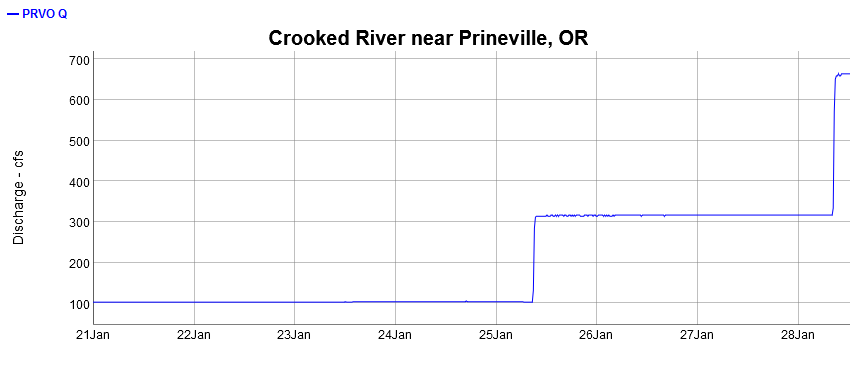
The Crooked below Bowman Dam is now at 664 cfs. The river coming into Prinveville Reservoir is at 4,200 cfs! The reservoir is over 70% full and capacity has to be reserved for more inflow this winter.
Read More »Watch those Crooked River flows
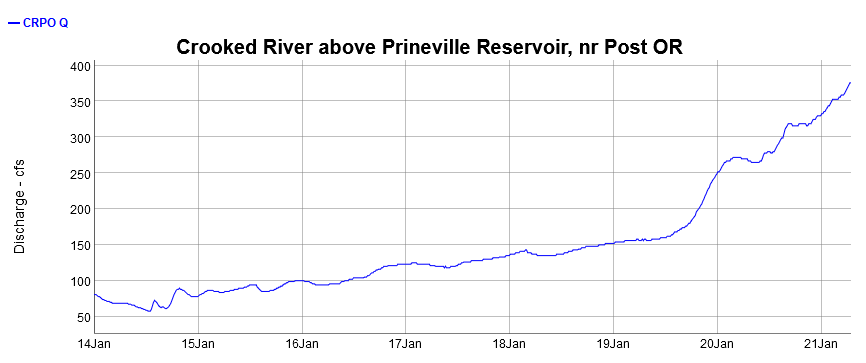
As I have recently been writing about, the Bureau of Reclamation has been warning of potentially needing to increase releases into the Crooked River from Prineville Reservoir in order to keep enough room in the reservoir to accommodate large inflows. Well, flows from snowmelt are happening now with the current rain on snow event. Above is the chart for the Crooked River coming into the reservoir. The releases from the dam have not been increased yet, but don’t be surprised if it happens.
Klamath Dams removal update
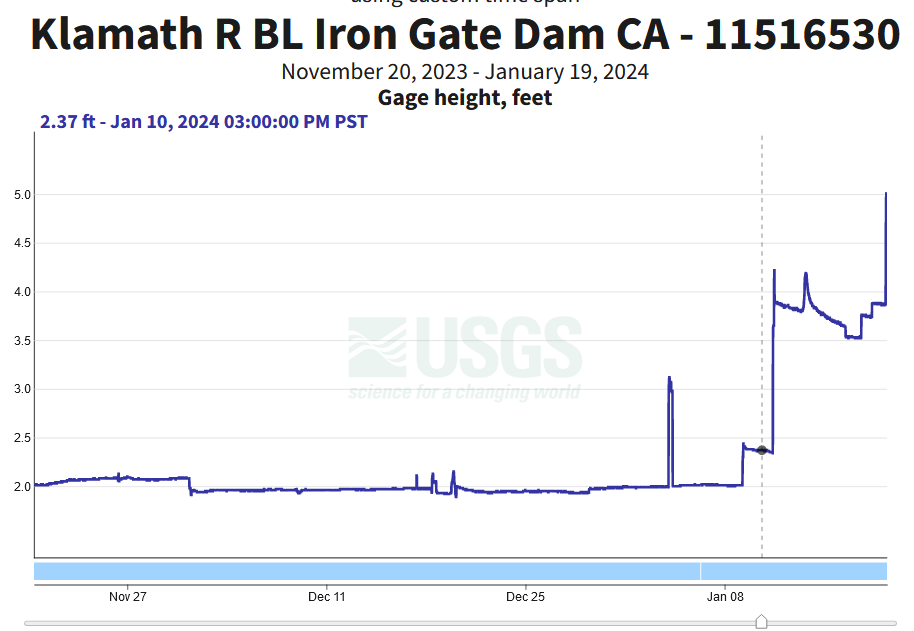
As you have probably heard, the reservoir drawdown behind some of the dams on the Klamath River has begun. See the chart above for the flows on the Klamath below Iron Gate Dam, the lowest of the dams that will be removed later this year. Here are some entertaining videos on YouTube showing the releases and an article with some background from OPB. Like many of you, I have been closely watching the dam removal for the obvious reason that removal is good for the environment but I also like to fish the Klamath River for steelhead. If you live in Central Oregon you might want to come to the next meeting of Central Oregon Flyfishers where I will present on fishing the river last year. Guests are always welcome.
WEF Global Risks Report 2024
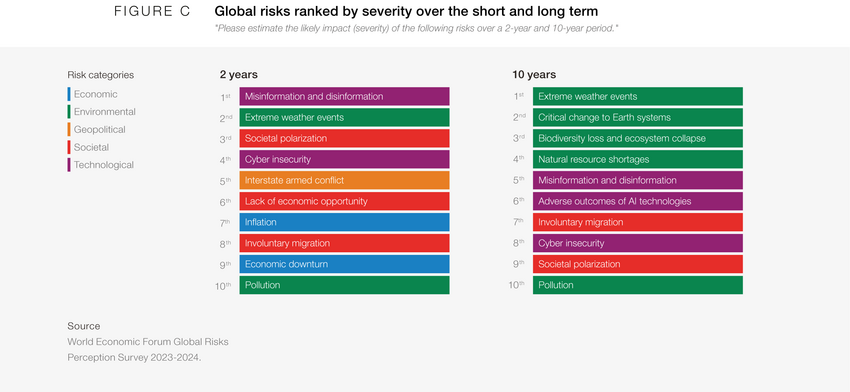
I occasionally post about economic topics when they are relevant to water issues, and the World Economic Forum Global Risks Report 2024, released 2 days ago fits the bill. It’s pretty concerning overall, the headline is “A deteriorating global outlook”, so have a cocktail ready. The biggest concern is “Trajectories relating to global warming and related consequences to Earth systems (Climate change)”. ”Environmental risks could hit the point of no return”. Follow the link if you can’t clearly see the chart above, but the top 4 risks over the next 10 years are environmental and they are 5 of the top 10. The economists are worried about how the environmental crisis will impact an already stressed global economic system. I am worried about the local the water crisis that is already upon us, will get much worse, and the fact that we are not adequately preparing for it. On a related note, see this article also from 2 days ago, “Climate Change Is Driving a Sharp Drop in Snow Levels, Study Finds“. It is based on this study, “Evidence of human influence on Northern Hemisphere snow loss”.
Prineville Reservoir release update
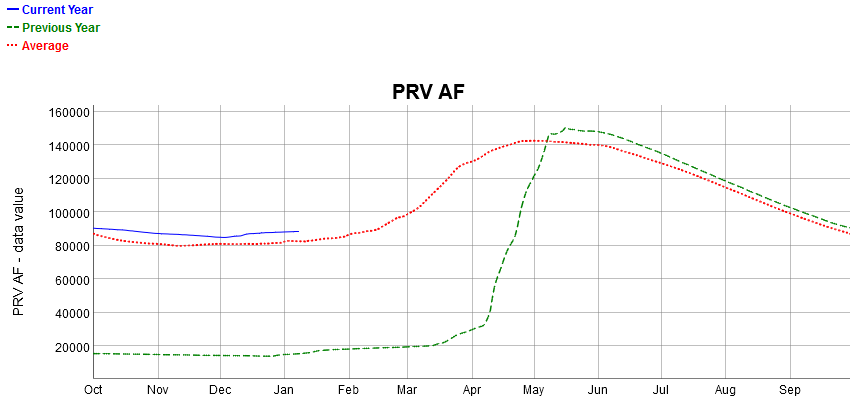
The monthly Prineville Reservoir/Crooked River update meeting occurred on January 3rd and I received the notes yesterday. See this post from last month for background. The reservoir level continues to be above average for this time of year* and is approaching the flood rule curve, which would require additional releases into the Crooked River, but as of January 3rd there had been little recent precipitation. There was discussion about the potential to release water in a gradual manner to be less detrimental to fish along with discussion about the uncertainty of future weather and potential dry scenarios.
* The reservoir level is above average as most of the precipitation in the drainage this water year has been rain rather than snow, or snow that soon melted.
NRCS Oregon water supply outlook
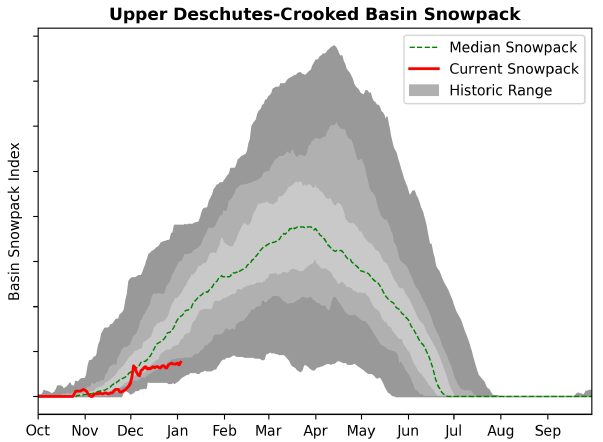
It’s premature to worry too much about the snowpack and it’s water content, but I think it’s time to start tracking the Natural Resources Water Conservation Service’s monthly water supply outlook report for Oregon. This is a comprehensive report with specific sections on the Upper Deschutes and Crooked River Basins. I’ll provide a few graphics, but I encourage you to at least scan the report. In short, precipitation and snowpack are well below normal for this time of year. As anyone who has lived in Central Oregon for a while knows, it’s foolish to predict the weather around here but we know we need multiple years of above average snow water equivalent to get back to what used to be considered normal.
Read More »Happy New Year (almost)
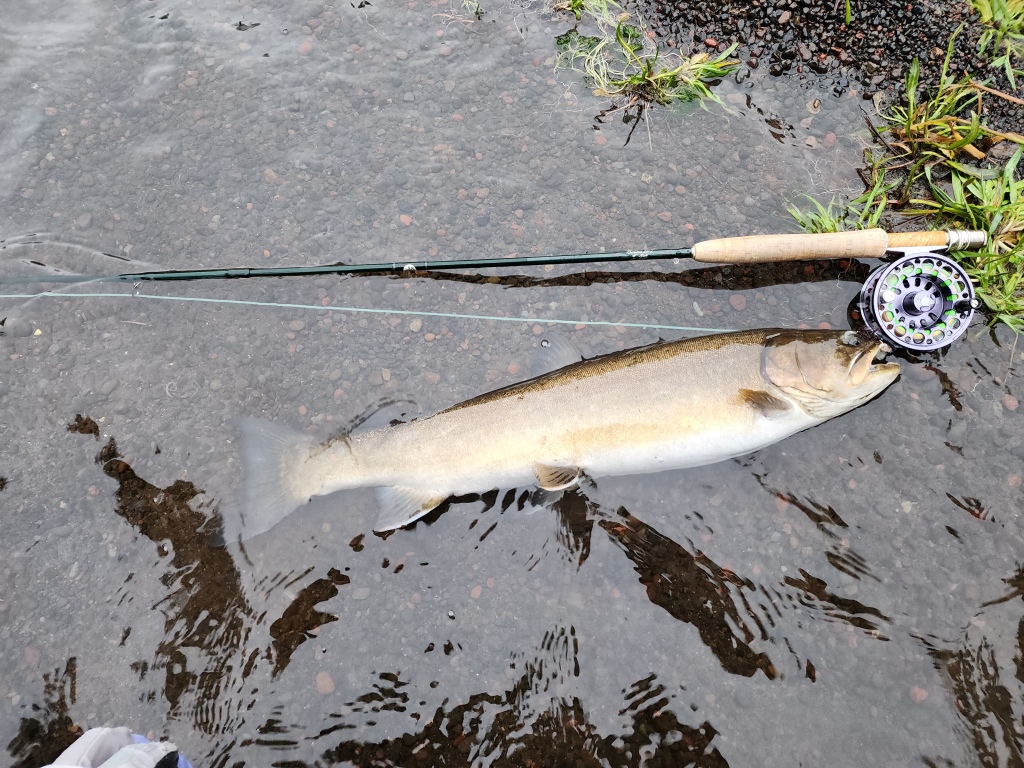
Here’s a ~25″ bull trout that I landed yesterday on the Metolius using a 5wt rod. Pretty fun. (The fish was never out of the water and vigorously swam away.) The cold weather and intermittent rain mixed with snow kept most anglers away which was an added bonus. Here are some Opal Springs videos from earlier this month.
Read More »Merry Christmas!
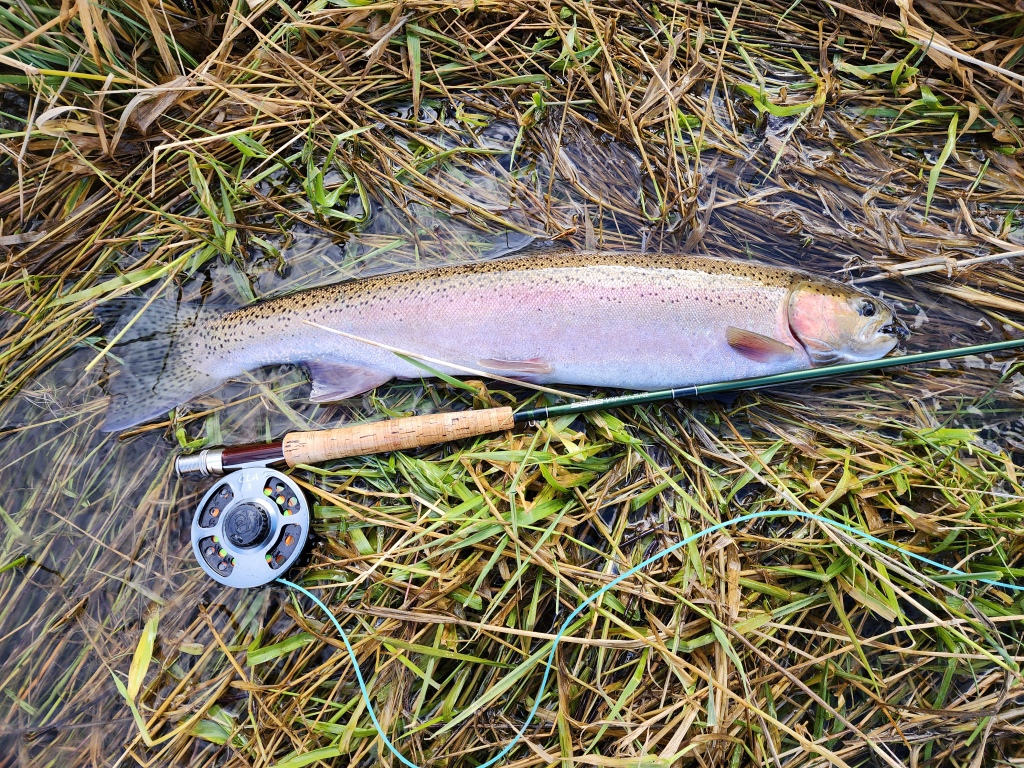
Fresh steelhead for Christmas Eve dinner anyone? I spent the past 2 days on the Lower Deschutes. It was cold but I have warm clothes and only saw one other boat both days. What’s a little ice on your rod, reel, and line? Just put it all back in the water. It’s really nice to have the day stretch pretty much to yourself. The first day was productive for multiple hookups and species, the next day was subfreezing in the morning and very slow. That’s fishing. Some of you might notice that’s a 6wt single hand rod and a small trout fly in the steelhead’s mouth. After mastering them, I have mostly stopped using 2 hand rods. They really are overkill if you are an experienced angler and I like the thrill and challenge of using lighter gear. Over the past year I have landed many steelhead and even chinook on various rivers using my 6wt single hand rod. It’s more sporting and a great feeling of accomplishment. I hope you have good fishing in 2024!
Stock runs and river kills
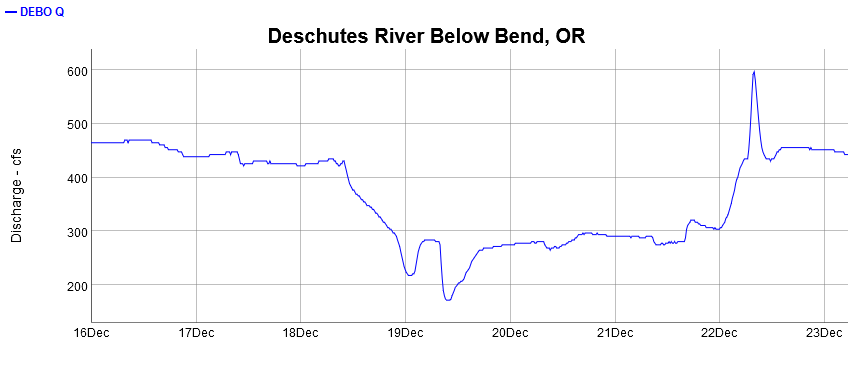
Central Oregon Irrigation District has now finished their latest “stock run” and you can see its impact on the Middle Deschutes below Bend. Over the course of 5 days the river level has fluctuated wildly with a low of 172 cfs and a high of 592 cfs. Such dramatic swings in a short period of time expose the river bed and its plants and aquatic insects to potentially lethally low temperatures. High flows then generate sediment which chokes spawning beds. Of course, this has been going on for years. With all the focus on restoring the Upper Deschutes (the river above Bend), the Middle Deschutes continues to be an irrigation ditch.
Read More »Prineville Reservoir increased discharge soon?
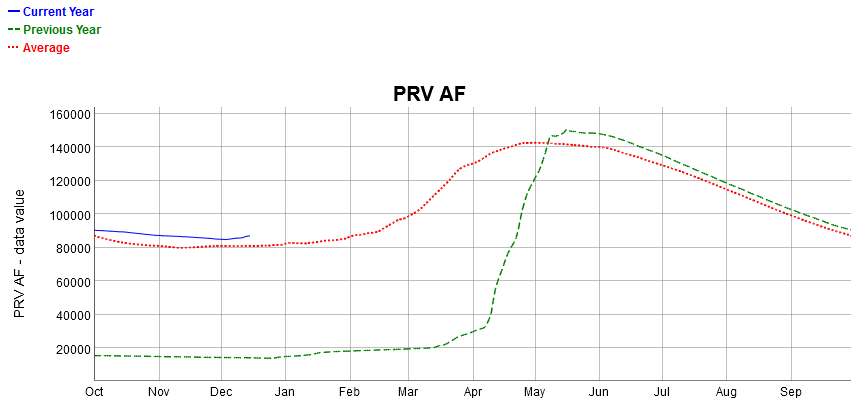
The Bureau of Reclamation hosts a monthly discussion for various stakeholders and agencies on the operation of Bowman Dam. The most recent meeting was on December 6 and I finally had the opportunity to read the notes. The bottom line is that anglers should be on the lookout for increased flows into the Crooked River, perhaps before the end of the month. Keep reading to understand why. The graph above is from the BoR and shows water measured in acre feet in Prineville Reservoir as of today.
Read More »Environmentalist vs taxpayer revisited
I recently posted about the conflict I feel as an environmentalist who wants local rivers and streams restored but also as a taxpayer who resents subsidizing hobby farmers. This is a common theme on this blog as well as the observation that there is no effective leadership looking at more equitable and lasting solutions to our water crisis. The Bulletin printed my post which generated the typical response: mostly positive email, a few angry ones, and this editorial from an agricultural industry lobbyist who apparently did not actually read my column or simply ignored what it said. Coincidentally, a few recent news reports clearly support my position.
Read More »Wizard Falls Hatchery Tour
I arranged a tour of the hatchery operations at Wizard Falls Fish Hatchery for Central Oregon Flyfishers earlier this week. In my 8 years on the ODFW Restoration & Enhancement board I toured many hatcheries and this tour was the most interesting. They were in the middle of “propagating” fish and I saw something new to me. Like many, I have mixed feelings about hatcheries. Clearly, intermixing wild and hatchery fish is a bad thing. On the other hand, if we want to fish lakes where trout do not naturally occur then they must be stocked with hatchery fish. I know I enjoy fishing those lakes.
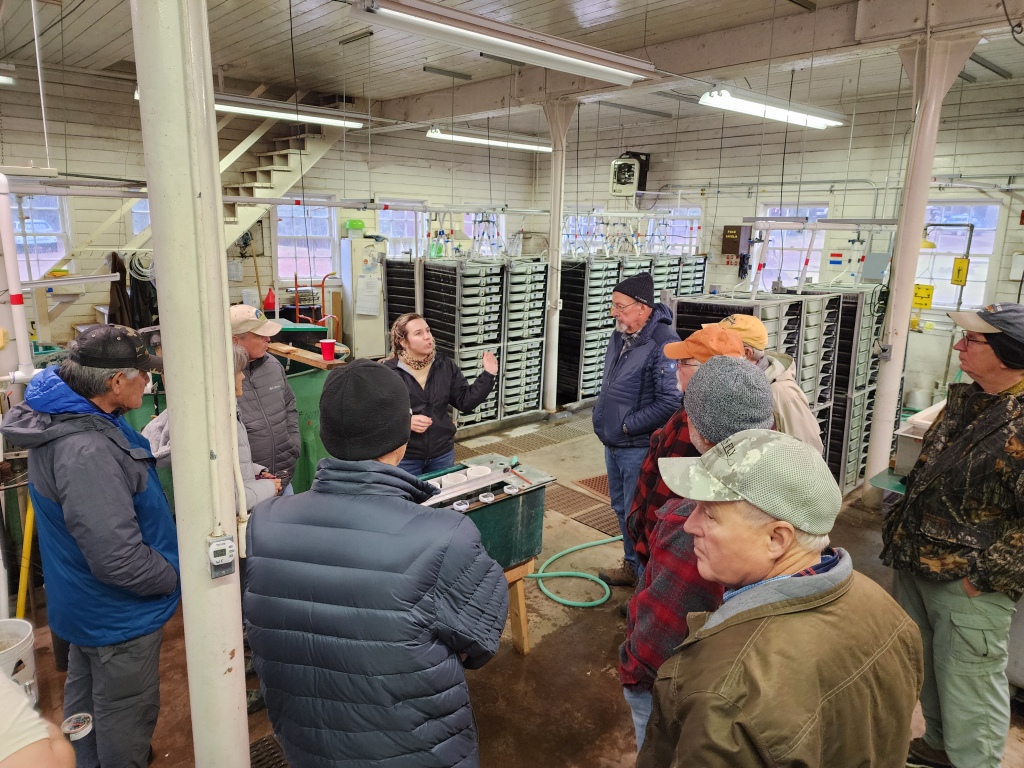
An environmentalist and a taxpayer
Last month the Oregon Water Resources Commission approved grants collectively worth $12,232,393 to Ochoco, Arnold, North Unit, and Tumalo irrigation districts for canal piping and related projects. With a total cost of $83,355,578, these efforts will place just under 30 cfs (cubic feet per second) of water back instream. The environmentalist in me understands the benefits of these projects. Our local rivers and streams are in terrible shape, impacting fish, wildlife, recreationists, and our local economy. The taxpayer in me is not enthusiastic about paying an average of $2,785,483 per cfs.
Read More »Whiskey is for drinking, water is for fighting
A few days ago the Bulletin carried a story from the Capital Press titled “Irrigators sue over Prineville Reservoir water releases“. As I mentioned in this post last month, when the Crooked River Act was passed in December 2014 it stated that water in excess of irrigation needs be released for the maximum biological benefit of fish all the way to Lake Billy Chinook. Unfortunately, that water was not protected with an instream water right which allowed water right holders downstream from the City of Prineville to withdraw it. It took 9 years (!) but that water was finally protected last month. Crooked River irrigators upstream from Prineville Reservoir are now suing to overturn that water right. This is absurd, the right does not affect them, and is another great example of how entitled and combative some water rights holders are.
Read More »Some recent Opal Springs fish videos
I have not shared any of these for a while, so here are a few very short videos of big fish swimming up the fish ladder at Opal Springs on the Crooked River.
Who uses all the water, revisited
As I detailed last August in “Who uses all the water?“, the majority of irrigators in Central Oregon are hobby farmers having less than $10,000 a year in revenue (not profit) and often losing money on operations. As I wrote in that post, “Real agriculture is important, but our local economy is diverse and primarily driven by people attracted to Central Oregon for the outdoor lifestyle. Shouldn’t water use support our current economy and rules governing its use be forward looking? Why should taxpayers provide massive support for hobbies? Perhaps most important, we are facing a climate crisis and can no longer afford the waste. It’s time for fundamental change.”
Last February Central Oregon LandWatch, the High Desert Food and Farm Alliance, and Central Oregon Community College surveyed Central Oregon Irrigation District patrons. The results of that survey were published on September 28. It’s a short and interesting article and I encourage you to read it. Earlier this month I asked COLW to see the raw data from the survey and was struck by the answers to two questions which reinforced my position.
Read More »Climate report & US Army Corp mistakes
Over the past 2 days, Oregon Public Broadcasting has had a few interesting articles. “What the new federal climate report says about the Northwest” states “the report emphasizes various impacts of climate change on the Northwest, predicting warmer winter temperatures, reduced mountain snowpack, more frequent and severe droughts, increased extreme rainfall, and larger, higher-elevation wildfires.” Note that it predicts more “extreme” rainfall, not more precipitation overall, and more droughts. Links to related articles worth reading are embedded. As the title implies, “9 times the US Army Corps of Engineers miscalculated badly at the expense of taxpayers, wildlife“, is pretty damning review of Corps projects (pun intended). Oregonians have plenty of examples of this, including dams on the Crooked and Deschutes Rivers.
Who should pay for irrigation modernization?
I’ve written about this many times, but a recent OPB article illustrated it once again: real farmers can pay. “Eastern Oregon group looks toward Columbia River to solve groundwater problems” is about farmers replacing groundwater with water from the Columbia River for irrigating their crops. I’m not informed enough to have a position on that and we certainly have experience with excessive surface water withdrawals destroying rivers around here. What struck me is that these farmers understand the need to stabilize and recharge aquifers, are looking to new water sources, and are paying most of the costs of switching “with less than 10% coming from government coffers”. I like that math. Other states have required farmers to upgrade their irrigation systems and pay the cost. Why can’t we do this in Central Oregon? Why are taxpayers shouldering the cost for modernization efforts? If an irrigator has an economically productive farm they should have a business model that includes the cost of production along with its upgrade and maintenance. Of course, hobby farmers they should pay for their hobby. This seems like Economics 101 to me.
Another view on the fish salvage
You’ve all heard about the annual fish “salvage” on the Upper Deschutes River above Bend. Periodic dewatering of the river by irrigation districts and the stranding of fish has been going on for decades but it recently has had negative press resulting in limited efforts made to save some fish. When this started I spoke to ODFW who said they wanted nothing to do with it. The salvage only occurs on a very small part of the river where hikers can easily see it, is mostly a feel-good PR event with no measurable biological impact, and the burden should be on the irrigation districts to better manage the river and perform any needed fish rescue operations. I stopped writing about this a long time ago, but here’s a recent no-holds-barred article on the topic from Bend resident George Wuerthner.
Running out of freshwater by 2040?
My avocation is water and fish zealot but I have a day job in an entirely different field that gives me access to interesting research reports, including some that examine the intersection between important trends and investing themes. A fascinating one on water came out yesterday from Merrill Lynch. It’s 185 pages and not for broad public distribution, but I can share the summary highlights. While the report is global in scope, there are themes that apply to residents of Central Oregon. (BTW, this report is written in British, not American, and those are not spelling errors.)
Read More »Crooked River flows and instream water right
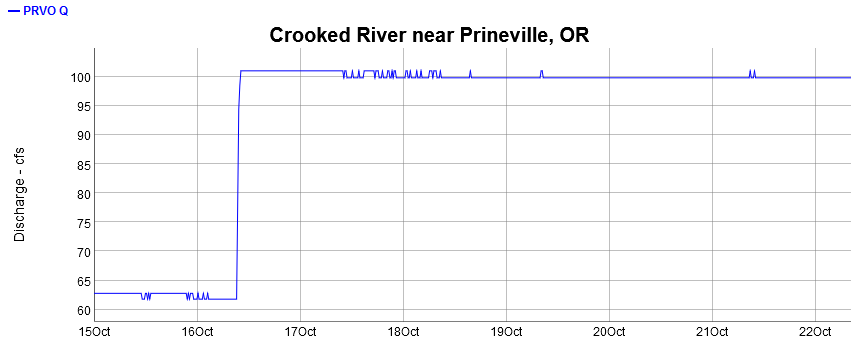
I’m a few days late on this, but I just had the chance to read the notes from the October 4 monthly meeting where Prineville Reservoir and Crooked River management is discussed. The notes (released October 16) stated that a healthy water balance in Prineville Reservoir will allow for releases of 100 cfs, hopefully through the winter, and should start on October 16. Checking the gauges I see this has occurred. Let’s hope for a wet winter and sustained winter flows in the Crooked!
Read More »More on local cities and groundwater
This is a wonky, insider sort of post that illustrates the lack of consensus inside the environmental community on important topics like groundwater. Following my recent posts on this topic I had an email exchange with a well known member of a high profile NGO that highlights how well meaning people can come to different conclusions on environmental policy. Do we want to preserve existing groundwater levels or should local cities be allowed to increasing pumping? I post this not to say I am correct and others are wrong, but to illustrate the tension within the community of people who are advocating for the environment within water world. It’s interesting and thought provoking for me.
Read More »The Middle Deschutes is still an irrigation ditch
I’m sure you have all been hearing about the end of irrigation season in Central Oregon, the reduction in flows coming out of Wickiup Dam as it is refilled, and the fish salvage operation just above Bend. You probably have not heard about the corresponding havoc on the Middle Deschutes, however.
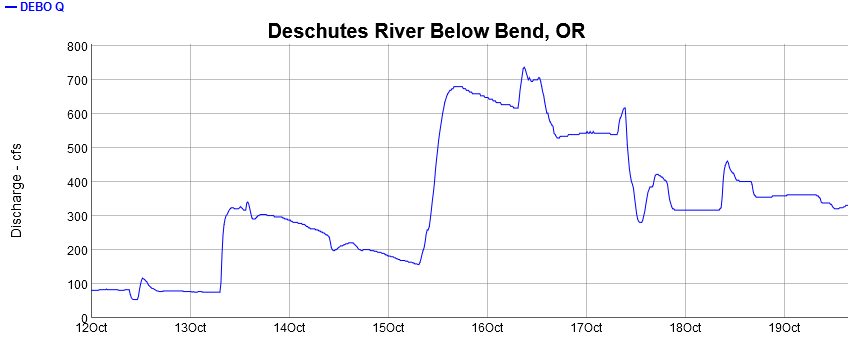
Rebuttal to “The Truth About PGE’s Stakeholder Process”
Yesterday the Deschutes River Alliance made a post titled “The Truth About PGE’s Stakeholder Process“. I really hesitated to write about this, from my perspective it’s a tired topic, but they made some claims that I simply cannot ignore. I was a member of the stakeholder process and have a very different perspective of what occurred. To state that the DRA is “the only NGO fighting for the lower Deschutes River” is simply ridiculous.
Read More »Reaction to “Local cities versus groundwater and the environment”
My recent post, republished in the Bulletin, generated the usual angry emails, mostly from people who had not carefully read what I wrote and emotionally responded to some imagined slight. For example, the NUID irrigator falsely claiming that I was advocating for taking away his water rights. I also received an email from a local elected official, to which I replied. I think it pretty well encapsulates the issue. If you are a voter, keep reading.
Read More »ODFW files claim again Winchester Dam owners
ODFW issued a press release today announcing a $27.6M (!) “claim of recovery” against the Winchester Water Control District (WWCD) and their contractors, “one of the largest damages claims for illegal killing of wildlife that has been filed in the state”. I have no idea how this will wind its way through the courts, but based on what I have read, it’s an amount that will be next to impossible for WWCD to pay. Perhaps a settlement can be reached that includes dam removal. Keep your fingers crossed. Use the search bar above and enter Winchester Dam to learn more.
Local cities versus groundwater and the environment
UPDATE: The Bend Bulletin reproduced this post in their opinion section today. They messed up the formatting and introduced a grammatical error, but I understand that they are struggling and appreciate the coverage.
Groundwater is declining at an alarming rate across the U.S. A heating planet and pumping at an unsustainable rate is threatening agriculture, domestic water use, industry, the environment, and fish & wildlife. The shortage in Arizona is bad enough to halt the construction of some housing developments and to rescind some agricultural water leases.
Read More »Groundwater declines: Oregon and nationwide
The NY Times recently added to their excellent series on nationwide groundwater declines. The latest article covers the astonishing amount of water being used for fracking. OPB continues to be an excellent source of information on groundwater declines in Oregon. This week, the Oregon Water Resources Commission is meeting in Harney County where they will discuss long overdue policy reforms, including critical groundwater areas. The Central Oregon Cities Organization (Bend, Redmond, Prineville, etc.) are in opposition to these reforms. Our tax dollars at work. The meeting is being held in Burns as Harney County is suffering from extreme groundwater declines.
Upper Deschutes Basin spring chinook 2023 returns
Writing the post I made earlier today reminded me that I have not written about this year’s spring chinook returns to the Upper Deschutes Basin. They remain grim. If this is the sort of reintroduction project that the tribes along the Upper Columbia River want to implement they should expect a long and disappointing effort. They should also expect to spend far more than $200M.
Read More »$200M for Columbia River salmon
You may have seen the news that last Thursday that the Biden administration pledged $200M for salmon restoration to tribes around the Upper Columbia River. These funds are to help with new hatcheries and a trap and haul operation around Grand Coulee and Chief Joseph dams. Both of these dams are well upriver from where the Snake River meets the Columbia River near Kennewick, Washington. I’m all for reintroducing anadromous fish into their ancestral waters, but this announcement is puzzling to me. There is no way that $200M is enough to “fully fund” reintroduction into the Upper Columbia and the approach being taken has a low probability of success.
Read More »N. Umpqua, Winchester Dam, and a chance to testify in Bend
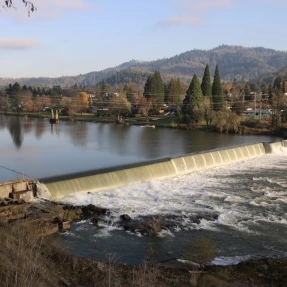
Almost 3 years ago, a coalition of groups filed suit to require repairs to the failing fish ladder on Winchester Dam on the North Umpqua River. The Native Fish Society has been doing an excellent job posting about this topic and the pathetic and potentially illegal actions taken by the dam owners. You can learn much more about this on the NFS news page. I am far from an expert on this topic, but it does appear shocking how state agencies like ODFW are not taking action to safeguard wild anadromous fish on the North Umpqua. NFS is now asking people to speak up at the ODFW Commission meeting in Bend on September 15. Learn more here and sign their petition, but attending the meeting is far more powerful.
Dammed to Extinction
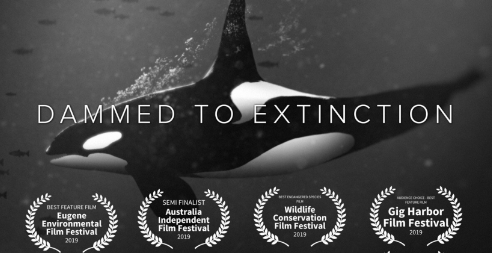
A benefit showing of the 50 minute film, “Dammed to Extinction“, will occur on September 14th, 7 pm, at the Sisters Movie House. “The Columbia River basin was once home to the world’s most productive chinook salmon runs. Now, they are blocked from reaching their home waters by dozens of dams along the Columbia, Snake, and other rivers in the watershed. Along the Pacific Northwest coast, pods of orcas have hunted chinook salmon. Yet wild chinook salmon here are increasingly scarce. The orcas are going hungry; their numbers dwindling along with their primary source of food. Extinction looms for both species. Following the film showing, we’ll be joined by Filmmaker Steven Hawley and other special guests to discuss the issues with the Lower Snake River dams and the hopes for a future of thriving salmon runs.”
Grab bag and some cool videos at the end
I’ve been preparing for my next fishing adventure, which starts tomorrow, and have not had the time to post, but as always there has been plenty to write about. So, here are a few short takes on Klamath Dam removal, the impact of ocean heating, our nationwide groundwater “crisis”, and some short videos of fish moving through Opal Springs dam.
Read More »Who uses all the water?
It has been estimated that agriculture uses approximately 86% of all water in Central Oregon. Municipalities use 2% and the rest stays in rivers and streams. These figures omit water from private wells, but regardless it is clear that agriculture uses most of the water. As our planet heats and extreme weather becomes normal, a closer look at water use is warranted.
Read More »Advocates for the West event in Bend
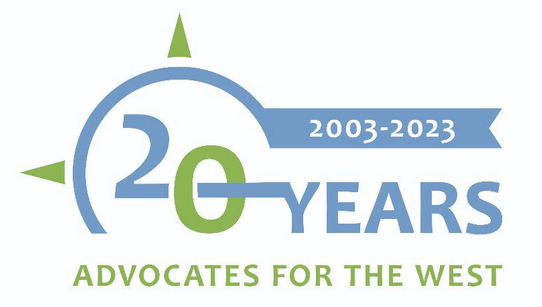
It’s not always a popular position, but I am a big fan of using the legal system to advance environmental causes. The judiciary is one of the branches of government and if the legislative and executive branches won’t protect our environment then we need to use the legal system. This seems simple and obvious to me.
Advocates for the West does exactly this at no cost to environmental groups who need help. They have had amazing success. They will be in Bend at Worthy Brewing next Tuesday, August 22nd, from 5:30 to 7:30. I’ll be there to hear the latest from their attorneys on legal battles to protect public lands, water, fish, and wildlife in Oregon. And drink a free beer too!
Maybe a little bit of good news for the Crooked River?
We all know that Prineville Reservoir filled this past winter and the Wild & Scenic section of the Crooked River below Bowman Dam has had good flows this spring and summer. Of course, this section of the river is rarely a problem during irrigation season. The river mostly suffers from low flows, sometimes lethally low, during storage season. Last week, the US Fish & Wildlife Service and National Marine Fisheries Service released their “final recommendation” for how to release the water stored in the reservoir for the remainder this year and through next winter. I’ll provide some discussion, but the bottom line is that if this plan is approved and implemented by the Bureau of Reclamation, reasonable amounts of water should be released into the Wild & Scenic section all winter. As usual, the problem on the Crooked River will be below that section.
Read More »“Shocking”: fish survey on Whychus Creek
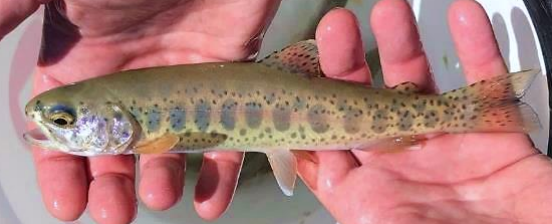
The final Deschutes Fisheries Workshop presentation that I will dive into was a report on fish population in Whychus Creek. It was “shocking” in the words of one fisheries biologist. I agree and had to go over the data again with the presenter to make sure I understood what was being said, which I did yesterday. Here’s the presentation. Keep reading for a discussion of what it says and some background that gives important context.
Read More »Another hobby farmer example
This afternoon I bought a quarter of a cow raised a few miles from where I live. Of course, I asked about the seller’s operation. He has a few cows but does not make a profit, he hopes to break even at some point, but the cows are simply a hobby at this point. He has 17 acres of COID water rights, but some of it is for extremely rocky land. COID has told him he needs to water it all or lose some of his rights, so he is going to do it. He is on a lateral where he and his fellow patrons have their gates open all the time, constantly filling their ponds, and run their wheel lines pretty much nonstop. He has old, leaky wheel lines and can’t afford to fix them. Even the less rocky land where he has wheel lines is not good enough to raise hay, whatever grows is what the cows eat, and he supplements with hay he buys. To be clear, I have no problem with people pursuing their hobbies and look forward to eating this locally raised beef, but clearly this is problematic. Unfortunately, this is not an unusual story.
Deschutes Fisheries Workshop presentations
I’ve already written about some of these, and will dive into one more soon, but PGE has posted all the presentations from the recent Fisheries Workshop. Of the ones I have not already covered, or plan to, I would draw your attention to “Lessons Learned from a Decade of Reintroduction”, “Adult Returns Update”, and “Pelton Round Butte Water Quality Update”. Good stuff, in my opinion.
Less than 3 days, more than 40 trout
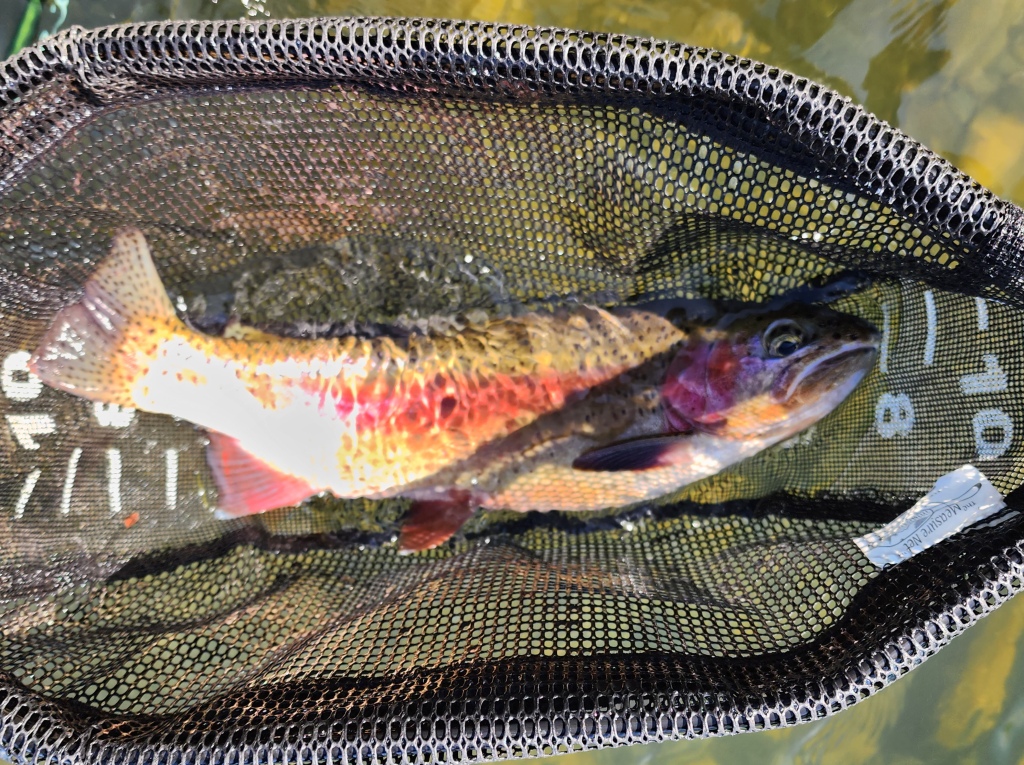
Yesterday my friend Tim and I finished up 3 days on the Deschutes, floating from Trout Creek to Harpham Flat. Like I said in this post from about a month ago, I don’t care what anyone with an agenda to promote says, the Lower Deschutes is in excellent shape. I had not been on this section of the river in some time, so I was curious about what I would find. The water was clear with no excess algae, aquatic plants were abundant and healthy, the banks were coated with caddis that birds and bats gorged on in the evening, black stonefly nymphs were everywhere in the river, and the fishing was excellent. The only bummer was that I landed 5 big Northern Pike Minnow, one of which was 15″ and 2 were 17″.
Read More »Small victory on Thornburg
Oregon Public Broadcasting, which continues to do a better job covering Thornburgh Resort developments than local outlets, reported yesterday that a new well permit has been denied. This is not a major setback for Thornburgh, at least not yet, and they can appeal it, but it certainly marks a welcome and overdue change on the part of the Oregon Water Resources Department who until recently seemed to approve every well permit they saw. Now, if only our county commissioners would stop approving everything that Thornburgh requests, this monstrosity might get scaled back. I’m not holding my breath.
Lower Deschutes River fish population estimates
One of the presentations I look forward to every year at the Deschutes Fisheries Workshop is the ODFW report on their annual fish population estimates. There are many who continue to argue that the operation of the selective water withdrawal tower has been detrimental to redband trout. Once again, the science says otherwise. Redband trout continue to do well. You can see the presentation below, but here’s a summary. Steelhead returns continue to be low. Clearly, this is not due to the SWW, steelhead returns are low throughout the entire Columbia River Basin. Coho salmon returns are increasing. Spring chinook returns are critically low. Fall chinook returns are robust. Smallmouth bass are exploding in the Columbia River and seasonally move up into the Deschutes but they are not spawning in the Deschutes.
Read More »Tui chub removal update
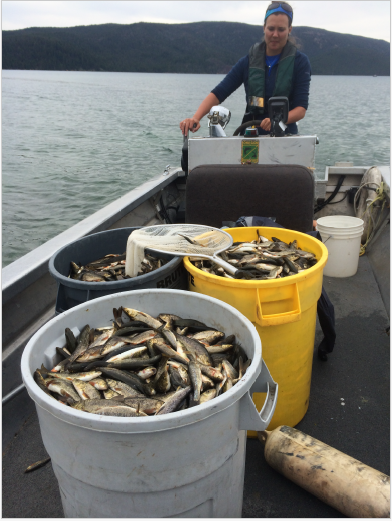
Here’s an update on high lakes tui chub removal, also given by Tim Porter, ODFW Assistant Fish Biologist, at last week’s Central Oregon Flyfishers meeting. As you probably know, ODFW works with OSU-Cascades, Lava Lake Resort, Paulina Lake Resort, and East Lake Resort to net invasive species which dramatically degrade the trout and kokanee fishing if left unchecked. Tui chub removal in the high lakes has been ongoing since 2010 except for a few years for monitoring or due to COVID (2020). Stocking the lakes with trout strains that may eat chub was ineffective while trapping has had good results. Thousands of pounds of chub are removed annually. Evidence of its effectiveness comes from angler reports and improved trout condition factors. Below is the presentation, it’s self-explanatory.
Read More »Annual Crooked River fish survey results
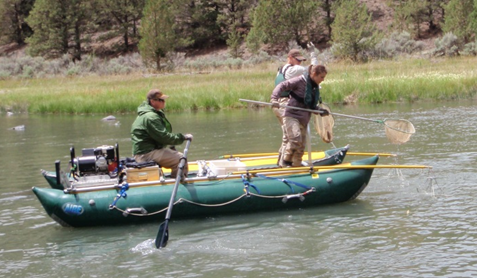
Almost every year the Oregon Department of Fish & Wildlife electrofishes the Crooked River to estimate redband trout and whitefish abundance. Following the very low flows on the Crooked River last fall, the results of the survey this spring were eagerly anticipated. The numbers were better than feared but showed a decline. Trout decreased by 20% from the prior year, mostly fish larger than 12″. Of course, larger fish are what anglers want to see. Additionally, the surviving larger fish had lower weights compared to the prior year indicating limited food availability. Fish can move to find survivable habitat much more successfully than macroinvertebrates, so it makes sense. Whitefish declined by about 50%. Plenty of anglers enjoy catching whitefish. Overall, the survey was bad news, but it could have been worse.
Read More »2022 steelhead smolt survival in the Crooked River
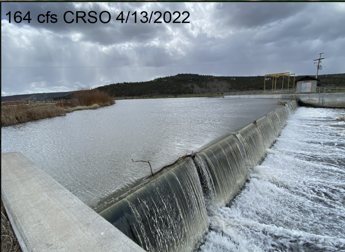
There were many very interesting presentations at the annual Deschutes Fisheries Workshop last week which I will be diving into soon. One of them was on downstream smolt migration and survival in the Crooked River in 2022. Last Wednesday Tim Porter, ODFW Deschutes District Assistant Fish Biologist, gave one of those presentations to Central Oregon Flyfishers where I was able to get many questions answered. In short, the presentation was alarming. Keep reading for the presentation and a discussion.
Read More »Frogs are not the problem
A recent story in the Bulletin, “Madras-area farmer testifies to U.S. House panel on impacts of endangered species”, failed to provide context. The story outlined how U.S. Congressman Cliff Bentz, chair of the House Committee on Natural Resources, recently held a hearing where a patron of North Unit Irrigation District testified that the Endangered Species Act is reducing water supplies to farmers in Central Oregon and endangering their livelihoods. As informed Central Oregonians know, this is a gross simplification and misrepresentation of what is going on. Unfortunately, clarification was not provided by the Bulletin.
UPDATE 7/25/23: The Bulletin printed this post.
Read More »The first dam is out
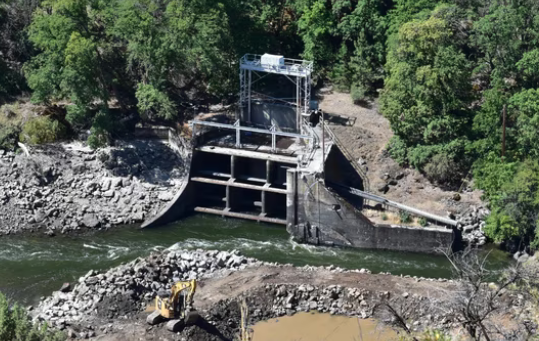
Oregon Public Broadcasting is doing an excellent job covering the removal of the dams on the Klamath River. Here’s their most recent story on the removal of Copco 2 with some cool photos and a video. I had a great time fishing below the dams last fall and really look forward to all the dams coming out.
Photo: Juliet Grable / JPR
Another lopsided story about water in the Bulletin
While there has been much to write about over the past month, I have been taking a break from posting to fish and recharge my batteries. (Last week’s Deschutes Fisheries Workshop had some really good presentations that I will be diving into soon.) An article in today’s Bulletin, however, has to be commented on. “After a promising spring, drought again stalking Central Oregon farmers“, had some good content but also omitted important elements. As readers of this blog know, I have said all along that the recent winter was not as good as many had been portraying it (e.g., calling it “promising”) and that the drought was not close to being over. Clearly, this impacts more than irrigators, which once again was the only aspect covered by the Bulletin.
Read More »Crooked River fish count: day 1
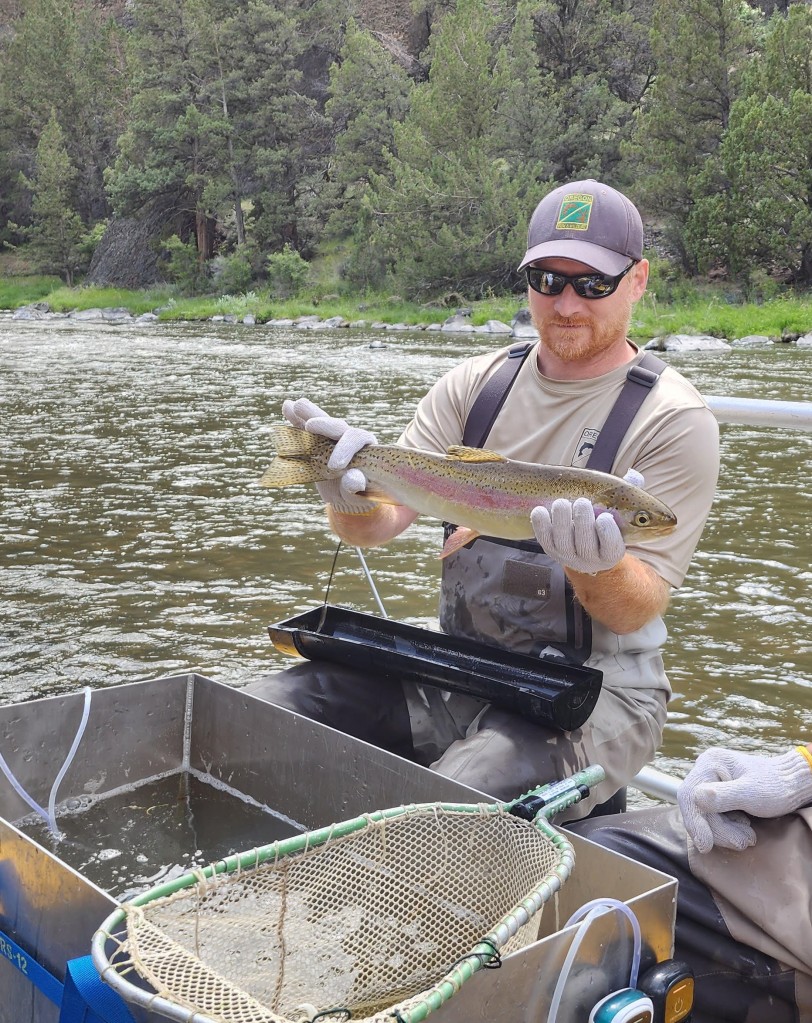
Today I helped with the first of four days of fish sampling on the Crooked River below Bowman Dam. The good news is that we captured some healthy redbands. As predicted, the numbers are definitely down from the past few years, maybe only a third as many, but there are fish in there. Extremely low flows and high temperature last fall, cold temperatures in the winter, and flows above the level that introduce gas bubble disease this spring made this an easy forecast. This 20.5″ fish was by far the largest, but had no adipose fin, so was almost certainly one that came down from Prineville Reservoir where hatchery fish are stocked. That is most likely going to be the case for most of the larger redbands in the river this year. Of course, it was only day one, so I look forward to the final results. The photo is of Tim Porter, ODFW Assistant Deschutes District Fish Biologist, who will present the findings of the survey and talk about other local fishery issues at the July 19th Central Oregon Flyfishers meeting.
Lower Deschutes: fishing report, heresy, and some cool photos
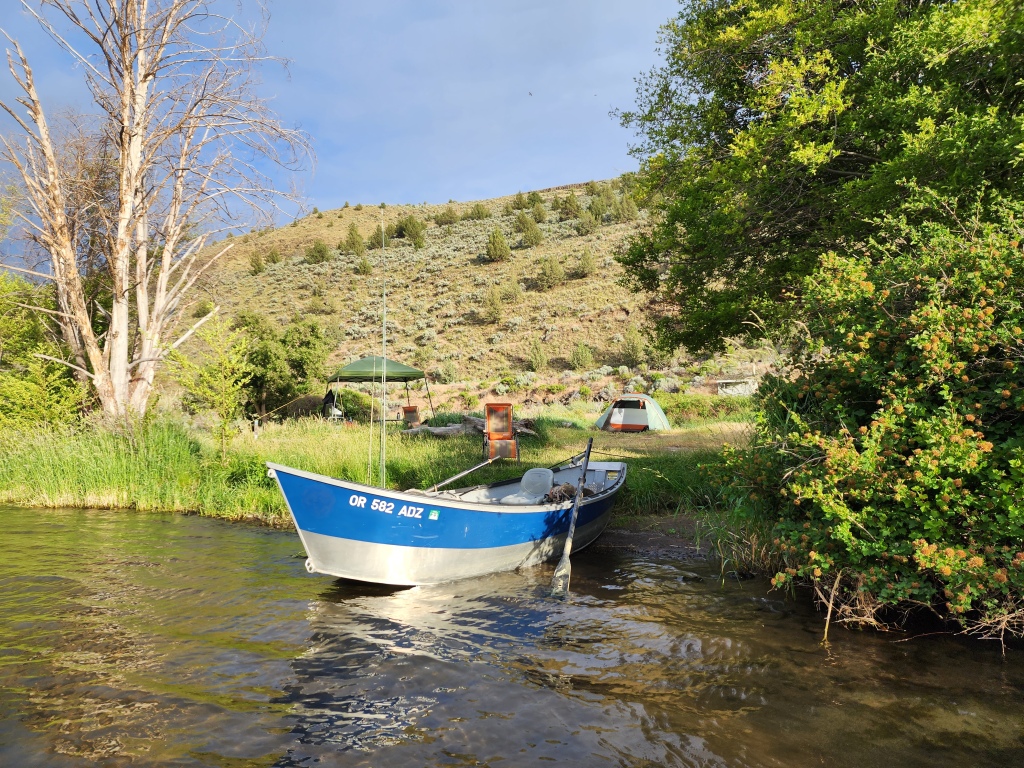
Yesterday my friend Scott and I finished up 3 days on the Lower Deschutes. This has been an annual spring trip for me for many years. I went on a couple of day trips before stonefly season but decided to wait until the crowds had dissipated before heading back. The fish are still there and, once again, the fishing was excellent. I don’t care what anyone with an axe to grind or agenda to promote says, the Lower Deschutes is in great shape. Fish, aquatic insects, birds, and bats were abundant. Caddis covered everything, including my face at times, which was irritating. Lots of snakes this year as well. Some extreme weather events have clearly occurred since I was last on the river about a month ago. Scott, a professional hydrogeologist, was impressed. Keep reading for more and some cool photos.
Read More »Water quality, science, and agendas
If you read this blog then you are most likely already aware that the Oregon Department of Environment Quality is currently proposing to update rules for temperature and dissolved oxygen standards in water bodies throughout the state. You can learn as much as you would like about this on their website. Earlier this week ODEQ held a Zoom meeting to go over the proposed changes, answer questions, and take public testimony. After reading most of the materials on the ODEQ website, watching the presentation, and listening to the public testimony, I was reminded of the keynote speech at the last Oregon Chapter of the American Fisheries Society meeting which encouraged professional fish biologists to not despair and continue to work on good science, even when so many detractors, even those claiming to represent fish, try to undermine their work.
Read More »ODFW Crooked River sampling: learn where the fish really hold
Every year ODFW electrofishes the Crooked River below Bowman Dam to estimate fish size, health, and abundance and they are looking for volunteer help June 21-23. Volunteers walk down the bank of the river while ODFW biologists float and shock the river. Fish near the boat are temporally stunned by the electric current and float to the surface where they are captured, counted, and measured. I first helped with this many years ago and it made me a far better angler on the Crooked and elsewhere. Even after decades of fishing experience and “reading the water”, I was amazed to see where fish were holding and in what numbers. If you are interested in helping, contact Tim Porter, Assistant District Fish Biologist in Prineville, at (541) 447-5111 ext. 24 or Timothy.K.Porter@state.or.us. Let him know which day(s) you can help and he will get back to you with more detailed info. You need to be able to carry buckets of stunned fish back upstream to release them near where they were captured. The day usually lasts from 8:30 am until 2 pm.
Oregon Department of Forestry Habitat Conservation Plan
This morning I attended the Oregon Department of Forestry Board of Forestry meeting in Sisters. Since 2019 the BOF has been working on the Western Oregon State Forest Habitat Conservation Plan. This plan is in draft form and is scheduled for adoption in November of this year. While the HCP was not on the agenda, a large crowd of opponents and supporters attended to voice their opinion during the public comment period. I had planned on giving comments as well, but after 2.5 hours I had not been called and most of the points I wanted to raise had already been made multiple times. This HCP should be of interest to all Oregon anglers, I’ll give a summary of why below. What was most interesting to me, however, was the clear divide between the camps. We all know the rancor that is gripping our state and nation. Some of the explanations I have read about these divisions have to do with “elites” and the “working class”. This seemed to be exactly the issue today.
Read More »The need for irrigation canal piping
Recently, there have been some articles and letters regarding canal piping in the Bend Bulletin. IMHO, many of them lacked important context, so I submitted yet another column on the topic, which was printed today. Of course, given the 650 word limit my column was cursory at best, but I think it got the point across. For those of you who do not have subscriptions (you should), here’s what I wrote.
Read More »Please comment on the latest IWRS
The State of Oregon is working on a revision to the Integrated Water Resources Strategy and is looking for public comment. Please take the survey before June 15. I have been highly critical of past versions of the IWRS, and based on the questions in the survey remain so. Once again, fish and wildlife are secondary concerns at best. This is not surprising given that the lead agency is the Oregon Water Resources Department which has a long history of serving agriculture, municipalities, and industry while ignoring input from the Oregon Department of Fish & Wildlife and the Oregon Department of Environmental Quality. I will say that OWRD seems to be getting better but they have a very long way to go to effectively balance consumptive use with environmental needs.
2022-2033 steelhead reintroduction final count
Attempts to reintroduce summer steelhead into the Upper Deschutes Basin above the Pelton Round Butte hydroelectric project on the Deschutes River have been ongoing for over a decade. This past season saw 131 returning adults moved up into Lake Billy Chinook, the largest number so far, where they will hopefully naturally spawn. 131 adult fish remains a disappointing number, but it is two to almost three times the count over the past few years, and it points to the success fisheries managers at Portland General Electric are having adapting their management strategies in the face of the deteriorating outlook for steelhead over much of the west coast of North America.
Read More »Bad news for fish in the Crooked and Middle Deschutes Rivers: CORRECTED
It’s irrigation season and, as usual, the Middle Deschutes is getting killed. Below are graphs showing flows in the Deschutes just below the Central Oregon Irrigation District and North Unit Irrigation District diversions at the North Canal Dam just upstream from the Mt. Washington bridge in Bend. As you can see, over the past two weeks fluctuations in the river have been abrupt and dramatic. This strands fish and other aquatic life and stirs up sediment that chokes spawning beds. (CORRECTION: in the section below on gas bubble disease, I missed a zero. Gas bubble disease is a real problem around 3,000 cfs, not 300 cfs as originally stated and now corrected. Sorry about that. Flows this morning out of Bowman Dam are are 2,020 cfs with inflows at 4,500 cfs.)
Read More »Columbia Basin steelhead presentation
If you are a fellow steelhead junkie, last night’s presentation by ODFW was excellent. You can see a recording by visiting their “Steelhead management in Columbia & Snake river basins” webpage. There was a ton of good information in the hour long talk, but here’s very brief summary. ODFW is currently working with forecasted returns for the upcoming season, which are lower than last year’s returns, but will watch actual returns and update regulations as needed. The current plan is to open the Deschutes for steelhead fishing on May 1 but to close it on August 15, prior to most fish getting above Sherars Falls. This is the opposite of what happened last year when the river was closed but opened on August 15 when actual returns exceeded the forecast. The John Day river is most likely to remain closed for a third straight year. Further east, the Grande Ronde and Imnaha rivers are projected to be open, although fish counts will be very low and they expect correspondingly low angling effort.
2023 ODFW Columbia Basin summer steelhead regulations
ODFW will host a webinar discussing the upcoming summer steelhead season on April 18. “For 2023, anglers should anticipate summer steelhead fishing restrictions and closures in the mainstem Columbia River and tributaries similar to previous years—including broad area and time closures, one-steelhead bag limits when open, and thermal angling sanctuaries near Oregon tributary mouths upstream of Bonneville Dam.” Get more information here.
“Pulse Flow” on the Crooked starting April 17
Here’s a message from ODFW: “The USFWS and NOAA have decided to release some water from Bowman Dam next week as a smolt pulse to help steelhead smolts move downstream. We’re trying to let as many constituents know as possible to help minimize inconveniences. The pulse flow will start on April 17 where they will slowly increase the amount of water released throughout the day to ramp up at an appropriate rate. The full 250 cfs pulse will be released all day on the 18th and 19th, and then will slowly be ramped back down to base flow on the 20th. We are uncertain at the moment what base flow will look like at that time since OID has indicated they may start releasing irrigation water on the 17th. Irrigation flows usually average about 200 cfs so the total amount of water could be anywhere from 250 cfs to 450 cfs.”
I would avoid fishing the river during the pulse flows. Given the low amount of water in Prineville Reservoir combined with continued uncertainty about timing and amount of snow melt and runoff into the reservoir, this is a pretty significant event.
The start of irrigation season and water outlook

Central Oregon Irrigation District has announced that their main canals will “turn on” starting April 10. North Unit Irrigation District is scheduled to start April 15. Nonetheless, I drove over a main canal today and it has water in it. So, here are some thoughts about the outlook for this irrigation season and its impact on local fisheries. We have been very lucky with late season snowfall, but it’s not as good as it is often portrayed to be. Our reservoirs, lakes, and rivers will need a lot more than one decent winter snowpack to return to healthy conditions.
Read More »Thornburgh Update
The latest in a series of Deschutes County commission meetings that have occurred over many years occurred last Wednesday, March 29. The current issue is appeals to a county hearings officer’s determination to deny Thornburgh’s request to modify their Final Fish & Wildlife Master Plan. The FWMP must be modified to accommodate changes that have been made to Thornburgh’s development plans. Thornburgh argues that the changes are minor while others argue that the changes are significant, and the entire plan must be resubmitted. The hearings officer denied Thornburgh’s request to make changes to the FWMP. If upheld, Thornburgh would be in violation of their approved development plan.
Read More »Bipartisan Drought Relief and Water Security Package
I am a frequent critic of local and statewide politician’s lack of attention to water use and scarcity but a small step in the right direction is currently being considered in the legislature. HB3124, titled the “Bipartisan Drought Relief and Water Security Package”, has elements that would begin to address important issues. It would direct the Oregon Water Resources Department to “study” drought (really, the legislature needs to direct OWRD to do this?) and include strategies for drinking water, agriculture, fish, and water projects. Locally, it would allocate $2 million to the Deschutes River Conservancy. The next public hearing and work session is on April 3rd. Keep reading for background information, some resources, and my criticisms (of course).
Read More »Another beautiful day on Lake Billy Chinook
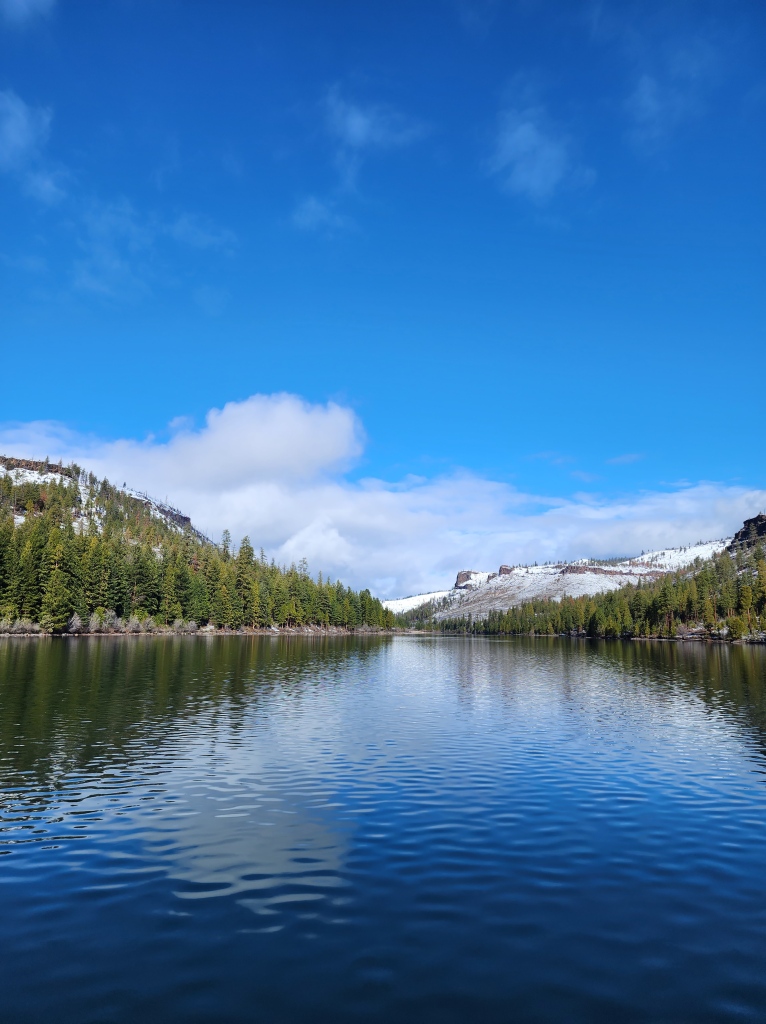
I only fish Lake Billy Chinook for a few weeks in the early spring for bull trout but really enjoy the time. Today was beautiful and it ended up being shirtsleeves weather. To top it off, I was able to get three bull trout in a morning of fishing. A great day. I went alone so did not have anyone to take any photos, but here is one from three days ago when a couple of friends were in the boat. We live in fishing paradise.
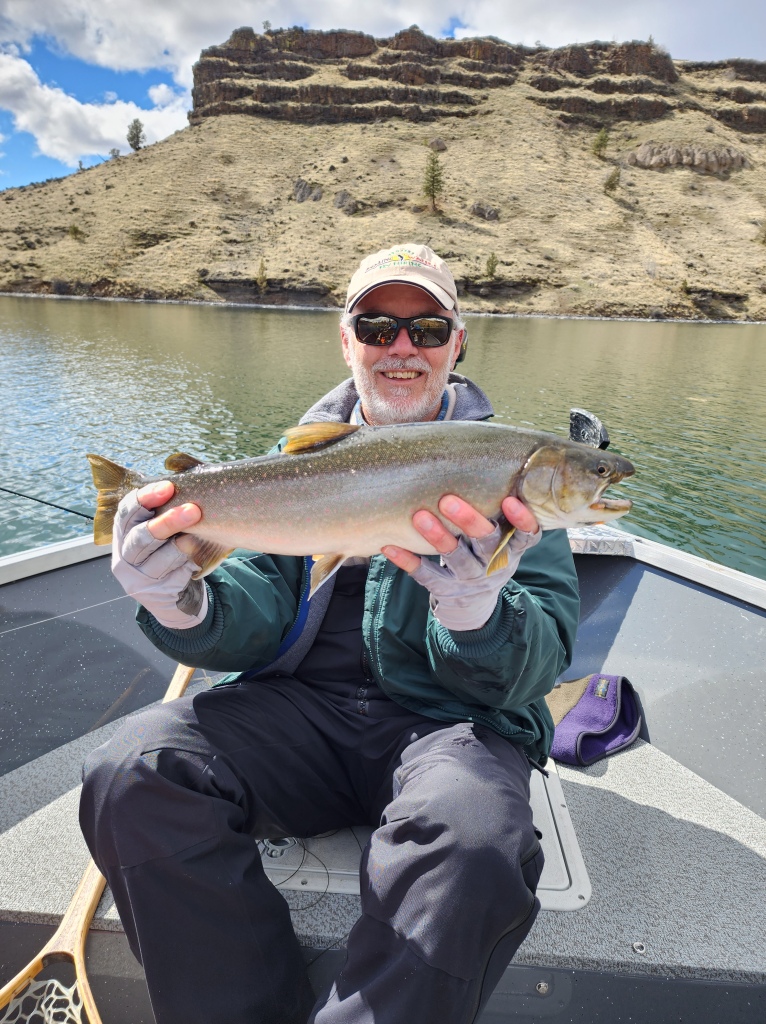
Global warming and fish hatcheries
Fish hatcheries are an intractable source of controversy in the angling community. Without them, most of the fishing that Oregonians enjoy would disappear since sportfish did not exist in most of our lakes prior to stocking. On the other hand, it is a scientific fact that hatchery fish released into rivers are an important contributor to the decline of wild fish. Speaking for myself as a wild, native fish bigot, I think there is an important role for hatcheries, but I wish that hatchery fish were not released into rivers where they can interact with wild, native fish. As a recent report commissioned by the Oregon Depart of Fish & Wildlife reveals, that may have to occur in some places in the coming years, but it is not necessarily good news for wild fish.
Read More »2 more years of chub removal
I have good news if you fish local high lakes. At the ODFW Restoration & Enhancement board meeting this last Thursday and Friday we funded a bunch of good projects including tui chub removal this summer and next in local high lakes and Diamond Lake. No, ODFW does not consider this a high enough priority project to entirely fund themselves. Brown bullhead catfish reduction in Crane Prairie is also going to happen, but this is being dictated by the Deschutes Basin Habitat Conservation Plan. Cat fish eat endangered frogs. BTW, if you know how to catch a brown bullhead on a fly, please let me know.
“Central Oregonians file more objections to Thornburgh resort proposal, but some feel helpless”
That’s the title of a OPB story that ran last week. It’s worth reading. I find it unbelievable that, as stated in the story, the developers of the resort continue to characterize it as something that is environmentally friendly and will actually benefit wildlife. Even a cursory glance at the Thornburgh website will correct any thinking person of that notion. Equally baffling is that our county commissioners and at least one local water-oriented nonprofit have drank the Kool-Aid. (I had the Executive Director of a prominent local non-profit recently tell me that Thornburgh won’t be that bad since they’ll only use a small amount of the total available groundwater, completely ignoring ODFW’s position that Thornburgh will have a negative impact on fish & wildlife.)
Spring chinook and Crooked River flows
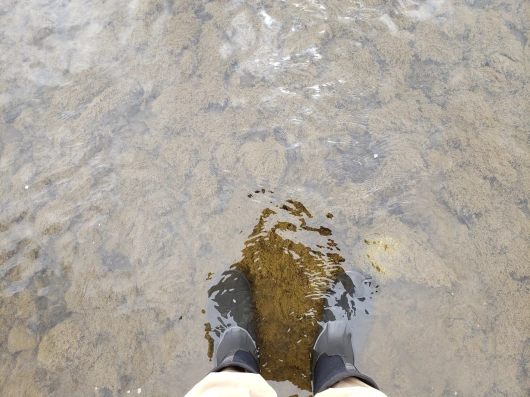
The Deschutes Valley Water District maintains a spreadsheet that identifies and counts the fish that pass through the ladder at Opal Springs Dam on their way up the Crooked River. It’s pretty interesting to see how many and how many different types of fish use the ladder. I had never even heard of a chiselmouth before seeing thousands of them in the spreadsheet heading up river to spawn in the spring. Anyway, I have been thinking about drought and local river levels and went back to correlate flows with spring chinook returns last summer. It was as bad as I expected.
Read More »Klamath Dam removal update
I spent the last three days at the annual meeting of the Oregon Chapter of the American Fisheries Society. It’s a scientific conference attended by fisheries biologists from the public and private sectors, but they let in me as well. One of the day long tracks on Thursday had to do with Klamath Dam removal, the largest dam removal project in history. Some of it was well over my head, like the talk titled “Responses of invertebrate hosts of salmon parasites to Klamath River flow events”, but there was a ton of useful information for anglers who treasure the Klamath Basin and look forward to what could be an improved fishing opportunity. Last month I was on the Klamath River in California below the dams and was impressed by the number of winter steelhead I hooked. If it can get even better it will be amazing. Keep reading for a very brief summary of the dam removal project.
Read More »Central Oregon water: is there a shortage?
Winter ends on March 19th and Central Oregon, like much of the Western US, remains in a drought. (The median high point for snowpack is March 27th.) The outlook is grim enough that Deschutes, Jefferson, and Crook Counties have once again declared drought emergencies. At the same time, local cities and municipal water system operators seem unconcerned. What’s going on?
Read More »It’s time for bull trout on Lake Billy Chinook

As readers of this blog know, the pursuit of bull trout using fly fishing gear dramatically changed with the reintroduction of steelhead and spring chinook salmon in the Upper Deschutes Basin. Prior to this, fly anglers would target bull trout chasing kokanee smolts in late winter and early spring as they moved out of the Metolius River. (The Metolius arm of LBC opens March 1, be sure to get your tribal permit.) Since reintroduction efforts began, however, salmon and steelhead have been planted in the Crooked and Middle Deschutes Rivers and their tributaries, making those arms of LBC attractive places to fish as well. This year there will be no salmon smolts planted due to insufficient hatchery production. 100,000 steelhead smolts will be released, however, half into the Crooked and half into the Deschutes. The first release is scheduled for tomorrow, February 23rd, in a tributary of the Crooked River. There will be 10 releases in total, the last occurring on April 27th.
Water is back in the opinion pages
A couple more good opinion pieces have appeared in the Bulletin. Jerry Freilich’s excellent column, “Perfect Balance ad was out of balance“, was published on February 15. It was a thorough dismantling of the disinformation contained in the recent half page advertisement from a group of irrigators calling themselves “Perfect Balance”. Today Tod Heisler had a column titled “Water distribution is based on fiction“. Tod summarized one of the topics that many of us have talked about for years, but which needs frequent repeating: we are in a period of water scarcity, the water we have has been over appropriated, and it needs to be reallocated. I agree 100% but also know that there is no political will to do this and the legal challenges would be played out over decades. My solution is to charge for water which will force many hobby farmers to give up their rights and allow real agriculture continued and improved access.
“Perfect Balance”?
On January 12 the Center for Biological Diversity announced their intent to sue the US Fish & Wildlife Service and the Bureau of Reclamation over the Deschutes Basin Habitat Conservation Plan. Shortly thereafter, the Bulletin published a column I wrote agreeing that the HCP has flaws but questioning the CBD for claiming that there are better solutions “that would help the frog and provide assurances to farmers down the road” without stating what they might be. Frankly, I am tired of environmental groups pointing out problems, which are real, without proposing solutions. I proposed a solution in my column. It has been an interesting few weeks since then.
Read More »2023 steelhead forecast: another bad year
Yesterday ODFW announced a preliminary forecast for “upriver” Columbia Basin summer steelhead returns. These are fish that migrate past Bonneville Dam to places like the Deschutes River and further inland. They believe that “returns will continue to be poor, marking what would be the 8th consecutive year of low returns.” ODFW warns anglers to expect continued angling restrictions in 2023. The primary issue is that while ocean conditions for some anadromous fish have improved, Columbia Basin steelhead move into waters that continue to be too warm to be productive. These early forecasts are notoriously inaccurate but the overall trend remains deeply concerning. I encourage you to read ODFW’s web page on this forecast, it is well written and filled with interesting information.
2022-2023 Deschutes River steelhead return puzzle
We all know that 2021-2022 returns were disastrously low for wild steelhead in the Deschutes and most of the Pacific Northwest. ODFW estimates that only 523 wild steelhead made it above Sherars Falls, compared to 1,935 the year before. The current 2022-2023 Deschutes steelhead return year still has a few months to go but surprising data is emerging. Wild steelhead counts have improved but are still low, barely above the threshold for survivability as established by ODFW. Upper basin origin reintroduced steelhead, however, are likely to have their best return year ever. With a few months to go, returns this year are already almost 3 times last year.
Read More »Thornburgh update
It’s been a while since I wrote about Thornburgh Resort since it seems to be in an endless loop. Today was the latest Deschutes County Commission meeting where no decision was made after 3 hours of testimony. The specific topic of this meeting is really secondary to the ongoing theme. Lawyers and experts for the developer are in a never ending argument with lawyers and experts for Nunzie Gould, the woman who has been suing to stop Thornburgh for 15 years. Add in the Oregon Department of Fish & Wildlife who says that Thornburgh has not proved they are meeting their obligation for no net loss of water. The new development today was the Confederated Tribes of Warm Springs now wants to get involved. I’m sure that other groups, most notably Central Oregon LandWatch, will soon put out a great description of the specific issues now being debated, but the bottom line is there is no end in sight. Regardless of what the County Commissioners decide in a month it will be appealed and the drama will go on. The good news is that there seems to be near universal public opposition to Thornburgh which has not always been the case. If you are a masochist you can watch a recording of the hearing here.
Exclusive farm use, water waste, and taxes
The Bulletin recently had an article and an editorial on a topic I have been writing about for a very long time. I first had an opinion column in the paper about how property taxes can encourage water waste about 6 years ago. It took the paper a while to fact check what I wrote, like most everyone they had not previously heard about this issue, but they did publish it. I wish I kept a copy of that column, but here’s a quick summary, followed by a discussion of the pros and cons of the bill recently introduced in the Oregon State Legislature intended to fix the problem. As always, the devil is in the details.
Read More »
